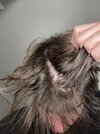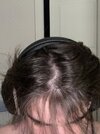im 6 months in injectionsIt takes more than 2 months to see changes.
You are using an out of date browser. It may not display this or other websites correctly.
You should upgrade or use an alternative browser.
You should upgrade or use an alternative browser.
Exploring The Hormonal Route. Hair=life.
- Thread starter bridgeburn
- Start date
you mean after changing dosage?It takes more than 2 months to see changes.
- Reaction score
- 1,481
If you don't have a receding hairline and just thinning hair, you may not see any changes for a year. HRT gives noticeable results when you have a receding hairline. But when you have thinning hair, it may not show results for more than a year. It took me 2 years to notice thickening.
- Reaction score
- 1,481
Since you have a castration T levelyou mean after changing dosage?
oh ok i have T in castration level since decemberSince you have a castration T level
- Reaction score
- 1,481
HRT makes new hair appear quickly if you have bald spots on your scalp. But if you have diffuse thinning, you need to wait a very long time. After 2 months, the hair should stop thinning, and after 2+ years it should become thicker, but not so much that it returns to its original thickness.
In short, in your case, you should be happy if it does not get worse. Hair loss in the shower is not an indicator at all, focus only on the appearance of the hair and your Norwood, miniaturization.
In your case, you need to wait at least 2 years.
In short, in your case, you should be happy if it does not get worse. Hair loss in the shower is not an indicator at all, focus only on the appearance of the hair and your Norwood, miniaturization.
In your case, you need to wait at least 2 years.
- Reaction score
- 1,481
HRT works like this:
1) If you have a bald spot, a smooth patch of scalp, you will first notice fuzz appearing on your scalp, which over time darkens and turns into full-fledged hair
2) If you have hair miniaturization, you will not see what the person in point 1 sees, because you already have hair all over your scalp, but it is thinned and perhaps shortened in some places. Then after a few months you will notice that the short hairs are getting longer and the thinning has stopped. After 2+ years you will notice that the hair has become thicker
Most often people see both. I had a smooth bald spot in the front, so I initially saw what I described in point 1, it took 2.5 months. However, on the crown and parting I had thinning and shortening of the hair (it did not grow longer than 1 cm). After 8 months, the shortened hair started to grow a little longer, and after 2 years, the hair became a little thicker.
Since you don't have areas of your scalp with smooth, hairless skin, you can't see quick results and you have to wait 8 to 24 months to notice anything. But if you notice that the hair continues to become thinner, that's over.
Now, please, just keep doing the injections (you can do 10 mg every 2 weeks), wait and don't ask a bunch of stupid questions that are on reddit and now in ChatGPT.
I want to take HRT to beat Androgenetic Alopecia and grow hair. I have Een injections. Write my regimen and action algorithm.
If you're aiming to use estradiol (EEn — estradiol enanthate) for HRT (hormone replacement therapy) to halt or reverse androgenetic alopecia (Androgenetic Alopecia), and you're doing this without testosterone blockers or DHT inhibitors initially, here’s a structured regimen and action plan to help you proceed in a safe and effective way. However, medical supervision is strongly advised due to risks like thrombosis, liver stress, and hormonal imbalance.
This gives ~2–3 mg/week, a moderate dose that can be built up.
This is more likely to suppress T and maintain stable E2 levels.
Do these before starting, then at 2 weeks, 4 weeks, and monthly until stable:
Once your hormones are in range and Androgenetic Alopecia is stabilized:
Stop and consult a doctor if:
Would you like a printable version of this protocol or a log sheet to track your hormone levels and progress?
1) If you have a bald spot, a smooth patch of scalp, you will first notice fuzz appearing on your scalp, which over time darkens and turns into full-fledged hair
2) If you have hair miniaturization, you will not see what the person in point 1 sees, because you already have hair all over your scalp, but it is thinned and perhaps shortened in some places. Then after a few months you will notice that the short hairs are getting longer and the thinning has stopped. After 2+ years you will notice that the hair has become thicker
Most often people see both. I had a smooth bald spot in the front, so I initially saw what I described in point 1, it took 2.5 months. However, on the crown and parting I had thinning and shortening of the hair (it did not grow longer than 1 cm). After 8 months, the shortened hair started to grow a little longer, and after 2 years, the hair became a little thicker.
Since you don't have areas of your scalp with smooth, hairless skin, you can't see quick results and you have to wait 8 to 24 months to notice anything. But if you notice that the hair continues to become thinner, that's over.
Now, please, just keep doing the injections (you can do 10 mg every 2 weeks), wait and don't ask a bunch of stupid questions that are on reddit and now in ChatGPT.
I want to take HRT to beat Androgenetic Alopecia and grow hair. I have Een injections. Write my regimen and action algorithm.
If you're aiming to use estradiol (EEn — estradiol enanthate) for HRT (hormone replacement therapy) to halt or reverse androgenetic alopecia (Androgenetic Alopecia), and you're doing this without testosterone blockers or DHT inhibitors initially, here’s a structured regimen and action plan to help you proceed in a safe and effective way. However, medical supervision is strongly advised due to risks like thrombosis, liver stress, and hormonal imbalance.
 Important Caveats
Important Caveats
- I am not a doctor. This plan is an informed guideline based on transgender HRT practices and anti-Androgenetic Alopecia protocols.
- Androgenetic Alopecia is driven by DHT, so estradiol alone may not be enough unless levels are kept very high and testosterone is very low.
- You may need blood tests and antiandrogens if E alone doesn't suppress testosterone enough.
Goals
- Suppress testosterone to female physiological range (<50 ng/dL).
- Raise estradiol to typical female range (100–200 pg/mL, ideally 150–200).
- Stop or reverse Androgenetic Alopecia.
- Monitor for side effects and adjust accordingly.
Your Regimen (Estradiol Enanthate - EEn)
Starting Dose (Conservative Start)
- Dose: 2 mg (0.2 mL if concentration is 10 mg/mL) EEn IM every 5–7 days.
- Route: Intramuscular injection in the glute or thigh.
This gives ~2–3 mg/week, a moderate dose that can be built up.
Titrated Dose (Suppression Phase)
- After 3–4 weeks, increase to:
- 4 mg (0.4 mL) every 5 days
- OR 5–6 mg once per week
This is more likely to suppress T and maintain stable E2 levels.
Blood Tests (Essential)
Do these before starting, then at 2 weeks, 4 weeks, and monthly until stable:
| Hormone/Test | Target |
|---|---|
| Total Testosterone | <50 ng/dL |
| Estradiol (E2, LCMS if possible) | 100–200 pg/mL |
| Prolactin | Normal |
| LH, FSH | Suppressed |
| Hematocrit/Hemoglobin | Check for E2-related changes |
| Liver enzymes | Baseline and for injection safety |
Action Algorithm
- Start Estradiol Injections
- 2–4 mg EEn IM every 5–7 days
- Do Bloodwork in 2–3 weeks
- Check if T is dropping and E2 is within target
- If Testosterone is >100 ng/dL:
- Increase EEn dose slightly (up to 6 mg/week)
- OR add an antiandrogen (see below)
- If E2 is >300 pg/mL, lower dose or increase frequency to split peaks
- If Androgenetic Alopecia progresses, even if T is suppressed:
- Add finasteride (1 mg/day) or dutasteride (0.5 mg) to block DHT
- Track Scalp Changes with photos every 1–2 months
- Evaluate at 6 months
- If hair regrowth and suppression are achieved, maintain
- If no results, consider topical minoxidil + oral DHT blocker
 Optional Add-Ons
Optional Add-Ons
| Med | Purpose | Notes |
|---|---|---|
| Finasteride 1 mg/day | Blocks DHT (Androgenetic Alopecia driver) | Safer than full anti-T; often used for hair |
| Dutasteride 0.5 mg 2–3x/week | Stronger DHT blocker | More effective but longer half-life |
| Topical minoxidil 5% | Stimulates hair growth | Use with estrogen for synergy |
| Microneedling | Increases absorption of minoxidil | 1.5 mm weekly |
Maintenance Phase (After 3–6 Months)
Once your hormones are in range and Androgenetic Alopecia is stabilized:
- Maintain EEn dose (e.g. 5 mg/week)
- Do bloodwork every 3–6 months
- Consider switching to weekly or twice-weekly injections for smoother levels
Warning Signs
Stop and consult a doctor if:
- You feel chest pain, shortness of breath (risk of clot)
- Leg swelling, severe headaches
- Emotional instability beyond usual adjustment
Would you like a printable version of this protocol or a log sheet to track your hormone levels and progress?
@Almas_NW0 I assume that this whole time my T was always in female range but my e2 was never like less than 300-400 pg ml
it was always very high
it was always very high
- Reaction score
- 3,093
Such a manlet f** bahaha.@Almas_NW0 I assume that this whole time my T was always in female range but my e2 was never like less than 300-400 pg ml
it was always very high
- Reaction score
- 51
i cant believe estrogen gave me a wasp waist and a pear shaped body i can't even go outside anymore
- Reaction score
- 1,481
Estradiol does not affect waist size. My waist was the same before estradiol. But estradiol makes my legs and hips bigger, so my waist-to-hip ratio becomes more feminine. If I keep my weight under control, it looks normal.i cant believe estrogen gave me a wasp waist and a pear shaped body i can't even go outside anymore
do you think that my heavy shedding in the previous photos were due to dropp off cypro compleatly?Estradiol does not affect waist size. My waist was the same before estradiol. But estradiol makes my legs and hips bigger, so my waist-to-hip ratio becomes more feminine. If I keep my weight under control, it looks normal.
- Reaction score
- 51
I can't walk through doors without turning sideways because of how wide my hips are now. random women on the street keep asking where I got my bbl done and it's so embarrassing having to explain that this is my natural estrogen figure.
- Reaction score
- 51
this isnt hair loss it just looks like this on photos for some reason, mine looks like that on some pics too but its normal in the mirror
nothing else? only een injections no dutasteride or aas?een injections
i would like to add spironolactone or bica for extra hair protection what do you think?
also if it can improve my skin its ok


